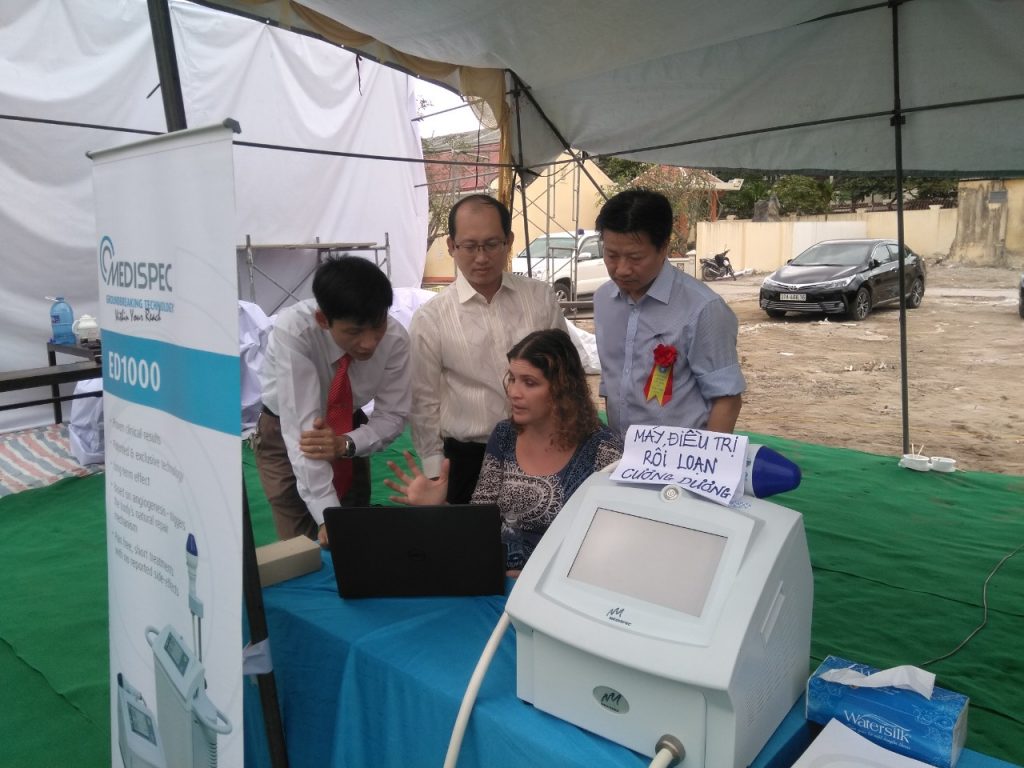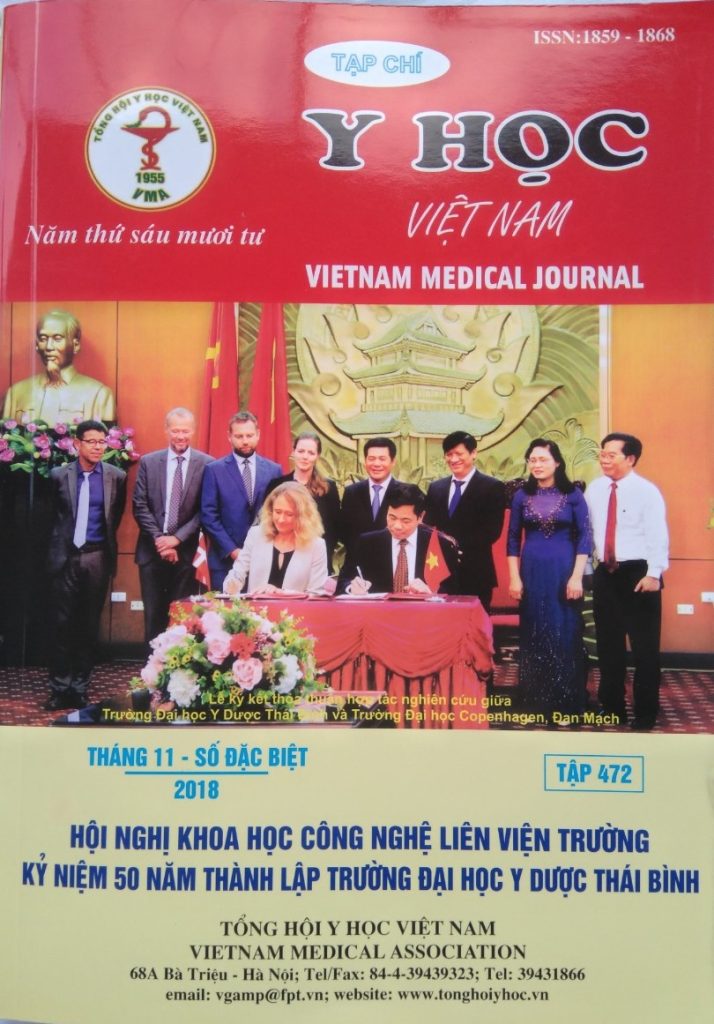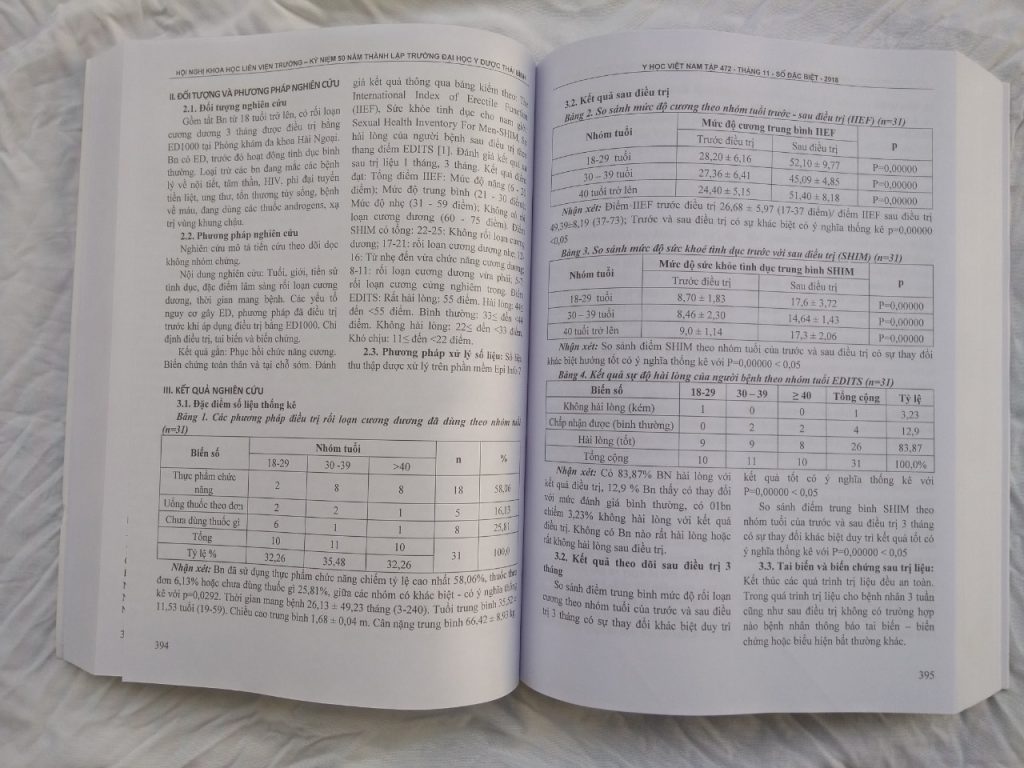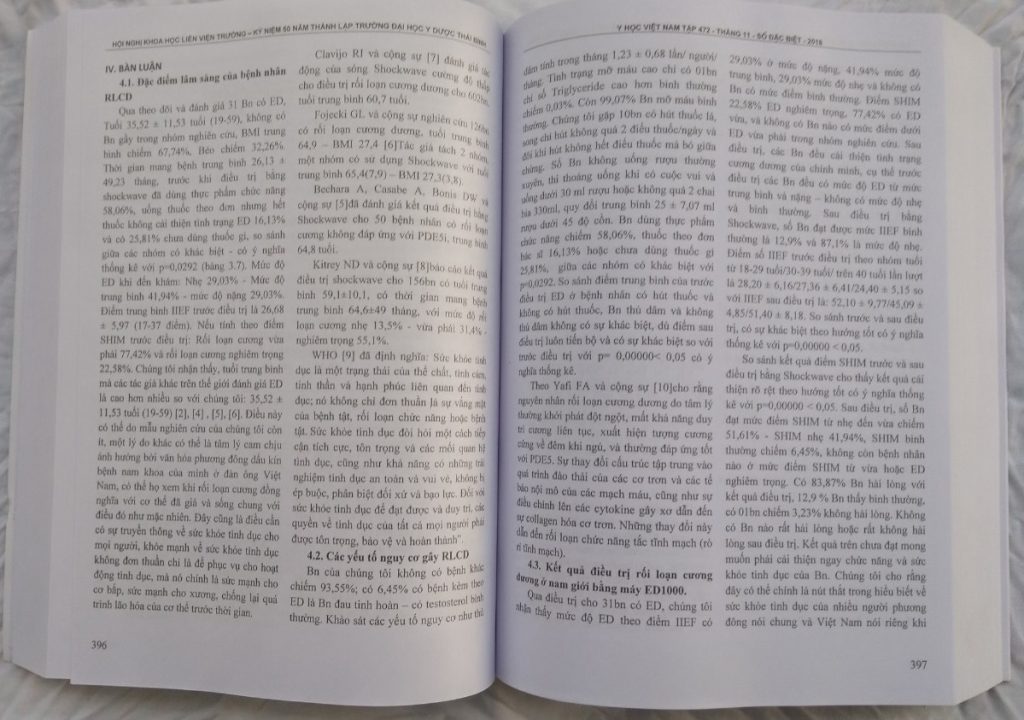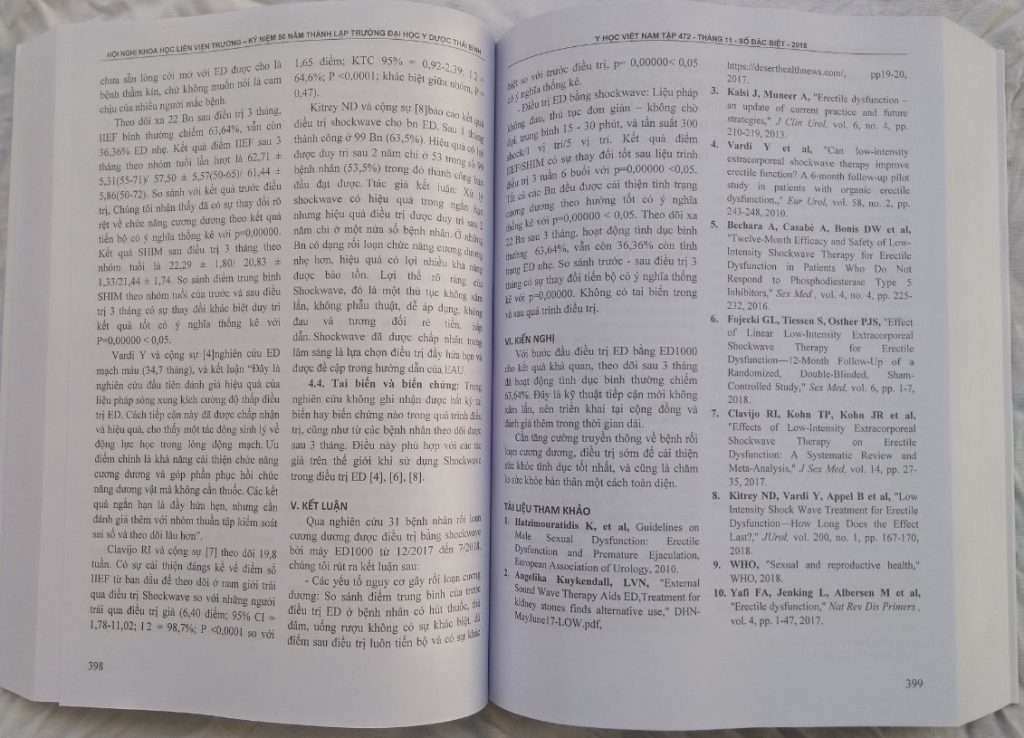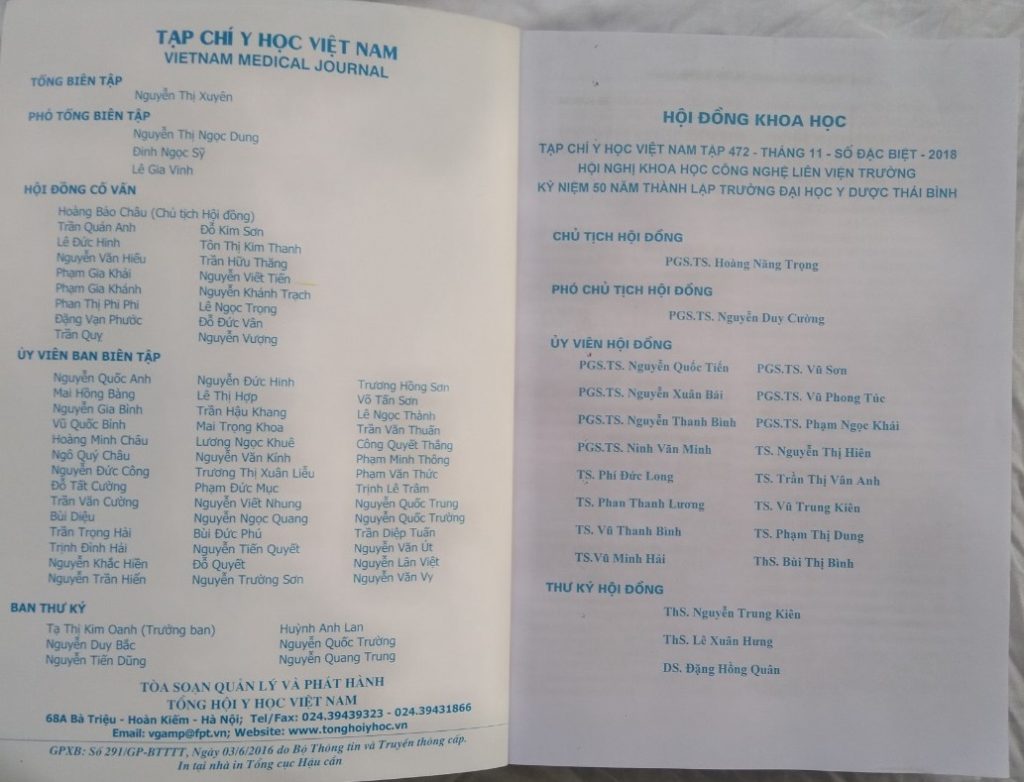TS.BS. Lê Ngọc Hải &cs
Tóm tắt:
Mục tiêu nghiên cứu: Nhận xét một số yếu tố nguy cơ gây rối loạn cương dương ở nam giới và đánh giá kết quả điều trị rối loạn cương dương ở nam giới bằng máy ED1000.
Đối tượng và phương pháp nghiên cứu: 31Bn có ED từ 12/2017 – 7/2018 tại PKĐK Hải Ngoại. Nghiên cứu mô tả tiến cứu theo dõi dọc không nhóm chứng với cỡ mẫu thuận tiện. Mô tả lâm sàng: Tuổi, tiền sử tình dục, đặc điểm ED, thời gian mang bệnh, yếu tố nguy cơ, phương pháp điều trị đã dùng, chỉ định điều trị Shockwave, tai biến, biến chứng, đánh giá kết quả theo IIEF, SHIM, EDITS.
Kết quả nghiên cứu: Tuổi 35,52 ± 11,53 tuổi (19-59), Thời gian mang bệnh 26,13 ± 49,23 tháng (3-240), dùng thực phẩm chức năng trước trị liệu 58,06%, không có sự khác biệt mức độ ED giữa các nhóm nguy cơ gây như hút thuốc, uống rượu, thủ dâm. Điểm IIEF trước điều trị 26,68 ± 5,97 (17-37 điểm)/ điểm IIEF sau điều trị 49,39±8,19 (37-73); so sánh giá trị IIEF trung bình trước và sau điều trị có sự khác biệt có ý nghĩa thống kê p=0,00000 <0,05; Điểm SHIM trước điều trị 8,71 ± 1,85 (5-11 điểm)/ điểm SHIM sau điều trị 16,45±2,83 (13-25); so sánh giá trị SHIM trung bình trước và sau điều trị có sự khác biệt có ý nghĩa thống kê p=0,00000 <0,05. Điểm IIEF/SHIM sau điều trị 3 tháng: 60,77±5,74(50-72)/21,55±1,68(20-25). Sau điều trị không có tai biến, biến chứng. Kết quả sau điều trị ED bằng shockwave có tiến triển tốt có ý nghĩa thống kê p=0,00000<0,05.
Kết luận: Với bước đầu điều trị ED bằng ED1000 cho kết quả khả quan, theo dõi sau 3 tháng đã hoạt động tình dục bình thường chiếm 63,64%.
Từ khóa: Rối loạn cương dương, ED, Shockwave, ED1000.
EVALUATION OF THE RESULTS OF TREATMENT OF ERECTILE DYSFUNCTION WITH ED1000 IN HAI NGOAI GENERAL CLINIC
Le Ngoc Hai &cs
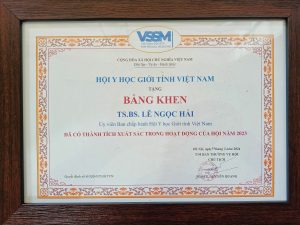
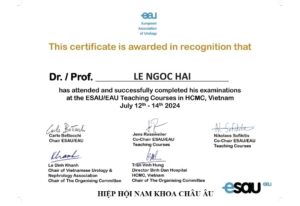
Abstract:
Objectives: To examine some of the risk factors for erectile dysfunction in men and to evaluate the results of treatment for erectile dysfunction in men with the ED1000.
Subjects and methods of study: 31 patients with ED from 12/2017 to 7/2018 at Hai Ngoai General Clinic. Descriptive study of vertical follow-up with convenient sample size. Clinical description: Age, sex history, ED characteristics, duration of disease, risk factors, treatment methods used, indications for Shockwave treatment, complications, evaluation of results according to IIEF, SHIM, EDITS.
Results: Age 35.52 ± 11.53 years (19-59), duration of disease 26.13 ± 49.23 months (3-240), using functional food before treatment 58.06%, no difference between ED levels among risk groups such as smoking, drinking, masturbation. IIEF scores before treatment were 26.68 ± 5.97 (17-37 points) / IIEF score after treatment 49.39 ± 8.19 (37-73); Comparison of mean IIEF values before and after treatment showed statistically significant difference p = 0.00000 <0.05; SHIM score before treatment 8.71 ± 1.85 (5-11 points) / SHIM score after treatment 16.45 ± 2.83 (13-25); Comparison of mean SHIM values before and after treatment showed statistically significant difference p = 0.00000 <0.05. IIEF / SHIM score after 3 months of treatment: 60.77 ± 5.74 (50-72) / 21.55 ± 1.68 (20-25). After treatment, there were no complications. The results of ED treatment with shockwave were progressive with statistically significance p = 0.00000 <0.05.
Conclusions: The first step to treating ED by ED1000 for satisfactory results, follow-up after 3 months have normal sexual activity constituted 63.64%.
Key words: erectile dysfunction, ED, Shockwave, ED1000.
Trích dẫn: Lê Ngọc Hải, và cộng sự: Đánh giá kết quả bước đầu điều trị rối loạn cương dương bằng máy ED1000, tại phòng khám Đa khoa Hải Ngoại. Tạp chí Y Học Việt Nam, tr392-399; số đặc biệt tháng 11. tập 472. 2018
TÀI LIỆU THAM KHẢO
| 1. | Hatzimouratidis K, et al, Guidelines on Male Sexual Dysfunction: Erectile Dysfunction and Premature Ejaculation, European Association of Urology, 2010. |
| 2. | Angelika Kuykendall, LVN, “External Sound Wave Therapy Aids ED,Treatment for kidney stones finds alternative use,” DHN-May June17-LOW.pdf, https://deserthealthnews.com/, pp 19-20, 2017. |
| 3. | Kalsi J, Muneer A, “Erectile dysfunction – an update of current practice and future strategies,” J Clin Urol, vol. 6, no. 4, pp. 210-219, 2013. |
| 4. | Vardi Y et al, “Can low-intensity extracorporeal shockwave therapy improve erectile function? A 6-month follow-up pilot study in patients with organic erectile dysfunction.,” Eur Urol, vol. 58, no. 2, pp. 243-248, 2010. |
| 5. | Bechara A, Casabé A, Bonis DW et al, “Twelve-Month Efficacy and Safety of Low-Intensity Shockwave Therapy for Erectile Dysfunction in Patients Who Do Not Respond to Phosphodiesterase Type 5 Inhibitors,” Sex Med , vol. 4, no. 4, pp. 225-232, 2016. |
| 6. | Fojecki GL, Tiessen S, Osther PJS, “Effect of Linear Low-Intensity Extracorporeal Shockwave Therapy for Erectile Dysfunction—12-Month Follow-Up of a Randomized, Double-Blinded, Sham-Controlled Study,” Sex Med, vol. 6, pp. 1-7, 2018. |
| 7. | Clavijo RI, Kohn TP, Kohn JR et al, “Effects of Low-Intensity Extracorporeal Shockwave Therapy on Erectile Dysfunction: A Systematic Review and Meta-Analysis,” J Sex Med, vol. 14, pp. 27-35, 2017. |
| 8. | Kitrey ND, Vardi Y, Appel B et al, “Low Intensity Shock Wave Treatment for Erectile Dysfunction—How Long Does the Effect Last?,” JUrol, vol. 200, no. 1, pp. 167-170, 2018. |
| 9. | WHO, “Sexual and reproductive health,” WHO, 2018. |
| 10. | Yafi FA, Jenking L, Albersen M et al, “Erectile dysfunction,” Nat Rev Dis Primers , vol. 4, pp. 1-47, 2017. |
BÁO CÁO TẠI ĐẠI HỌC Y DƯỢC THÁI BÌNH 2018
